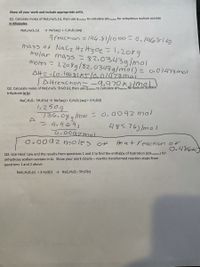
Chemistry
10th Edition
ISBN: 9781305957404
Author: Steven S. Zumdahl, Susan A. Zumdahl, Donald J. DeCoste
Publisher: Cengage Learning
expand_more
expand_more
format_list_bulleted
Concept explainers
Question
Question 3

Transcribed Image Text:Show all your work and include appropriate units.
Q1. Calculate moles of NaC2H3O2 (s), then use greaction to calculate AHreaction for anhydrous sodium acetate
in kilojoules.
NaC2H3O2 (s)
→ Na*(aq) + C2H3O2 (aq)
greaction = 146 81/1000=0.146S1kg
mass of NaC2 HZH3OZ=lu2089
molar mass =82.03439/mol
moles = 1.208g/82.03439/m01) = 0.01473mol
AH= -(0.14681KT/0.01473méi
DHreaction=-9.970K)/mold
Q2. Calculate moles of NaC2H3O2 3H20 (s), then use greaction to calculate AHreaction for sodium acetate
trihydrate in kJ.
NaC2H3O2 3H20 (s) → Na*(aq) + C2H3O2 (aq) + 3 H20(1)
1.2509
136.08glmoi = O. 009z mol
ニ 4.469
485.76)/mol
O.0097mol
Oo 0o dz moles of
He a +reaction ok
0.486K)
Q3. Use Hess' Law and the results from questions 1 and 2 to find the enthalpy of hydration (AHreaction) for
anhydrous sodium acetate in kJ. Show your work clearly - rewrite transformed reaction steps from
questions 1 and 2 above.
NaC2H3O2(s) + 3 H20(1) → NaC2H3O2 3H2O(s)
Expert Solution
This question has been solved!
Explore an expertly crafted, step-by-step solution for a thorough understanding of key concepts.
This is a popular solution
Trending nowThis is a popular solution!
Step by stepSolved in 2 steps with 2 images

Knowledge Booster
Learn more about
Need a deep-dive on the concept behind this application? Look no further. Learn more about this topic, chemistry and related others by exploring similar questions and additional content below.Similar questions
- I got the answer wrong, this was the reply "It looks like your answer is off by a factor of 100. Check the math you used to arrive to your answer and try again."arrow_forwardis urine homogeneous or heterogeneous mixture?arrow_forwardWhich is a property of a nonmetal? A. Poor conductor of electricity B. Solid at room temperature C. Shininess D. Good conductor of heatarrow_forward
- A chemist working as a safety inspector find an unmarked bottle in a lab cabinet.arrow_forwardWhat is the scientific method answers to the freezing point of waterarrow_forward2-86 When each of the following measurements are length is convert to inches, using a conversion factor obtained from the equality 1 foot = figures should the answer have?, 12 inches, how many significantarrow_forward
- Discuss the language demands included in the lesson on mixing substances in a 5th-grade classroom by Identifying key vocabulary terms students must know in order to master the learning objectives for the lesson based on the below standard and learning objective. Standard Conduct an investigation to determine whether the mixing of two or more substances results in new substances. Learning Objective Given a variety of substances and safety equipment in a classroom setting, students will be able to conduct an experiment to mix two or more substances and observe the results. They will be able to correctly identify whether a new substance has been formed as a result of the mixing, based on observable changes such as color change, formation of a precipitate, or change in temperature, with at least 80% accuracy.arrow_forwardI need help with the blank tables on the page as well as the question on the bottomarrow_forwardan introduction on a research scientistarrow_forward
- » Significant Figure Rules 01 >> 02 >> 03 >> 04 >> 05 >> All nonzero digits are significant. Zeros that appear between other nonzero digits are always significant. Zeros that appear in front of all of the nonzero digits are called left-end zeros. Left-end zeros are never significant. Zeros that appear after all nonzero digits are called right-end zeros. Right-end zeros in a number that locks a decimal point are not significant. ▬▬▬ 美銀銀時 ☐☐ Right-end zeros in a number with a decimal point are significant. This is true whether the zeros occur before or ofter the decimal point. 237 has three significant figures. 1.897 has four significant figures. 39,004 has five significant figures. 5.02 has three significant figures. 0.008 has one significant figure. 0.000416 has three significant figures. 140 has two significant figures. 75,210 has four significant figures. 620.0 has four significant figures. 19.000 has five significant figures. For multiplication and division problems, the answer…arrow_forwardQuestion 2, B, C, D, And Earrow_forwardSubstance Physical Appearance Fe S FeSarrow_forward
arrow_back_ios
SEE MORE QUESTIONS
arrow_forward_ios
Recommended textbooks for you
 ChemistryChemistryISBN:9781305957404Author:Steven S. Zumdahl, Susan A. Zumdahl, Donald J. DeCostePublisher:Cengage Learning
ChemistryChemistryISBN:9781305957404Author:Steven S. Zumdahl, Susan A. Zumdahl, Donald J. DeCostePublisher:Cengage Learning ChemistryChemistryISBN:9781259911156Author:Raymond Chang Dr., Jason Overby ProfessorPublisher:McGraw-Hill Education
ChemistryChemistryISBN:9781259911156Author:Raymond Chang Dr., Jason Overby ProfessorPublisher:McGraw-Hill Education Principles of Instrumental AnalysisChemistryISBN:9781305577213Author:Douglas A. Skoog, F. James Holler, Stanley R. CrouchPublisher:Cengage Learning
Principles of Instrumental AnalysisChemistryISBN:9781305577213Author:Douglas A. Skoog, F. James Holler, Stanley R. CrouchPublisher:Cengage Learning Organic ChemistryChemistryISBN:9780078021558Author:Janice Gorzynski Smith Dr.Publisher:McGraw-Hill Education
Organic ChemistryChemistryISBN:9780078021558Author:Janice Gorzynski Smith Dr.Publisher:McGraw-Hill Education Chemistry: Principles and ReactionsChemistryISBN:9781305079373Author:William L. Masterton, Cecile N. HurleyPublisher:Cengage Learning
Chemistry: Principles and ReactionsChemistryISBN:9781305079373Author:William L. Masterton, Cecile N. HurleyPublisher:Cengage Learning Elementary Principles of Chemical Processes, Bind...ChemistryISBN:9781118431221Author:Richard M. Felder, Ronald W. Rousseau, Lisa G. BullardPublisher:WILEY
Elementary Principles of Chemical Processes, Bind...ChemistryISBN:9781118431221Author:Richard M. Felder, Ronald W. Rousseau, Lisa G. BullardPublisher:WILEY

Chemistry
Chemistry
ISBN:9781305957404
Author:Steven S. Zumdahl, Susan A. Zumdahl, Donald J. DeCoste
Publisher:Cengage Learning

Chemistry
Chemistry
ISBN:9781259911156
Author:Raymond Chang Dr., Jason Overby Professor
Publisher:McGraw-Hill Education

Principles of Instrumental Analysis
Chemistry
ISBN:9781305577213
Author:Douglas A. Skoog, F. James Holler, Stanley R. Crouch
Publisher:Cengage Learning

Organic Chemistry
Chemistry
ISBN:9780078021558
Author:Janice Gorzynski Smith Dr.
Publisher:McGraw-Hill Education

Chemistry: Principles and Reactions
Chemistry
ISBN:9781305079373
Author:William L. Masterton, Cecile N. Hurley
Publisher:Cengage Learning

Elementary Principles of Chemical Processes, Bind...
Chemistry
ISBN:9781118431221
Author:Richard M. Felder, Ronald W. Rousseau, Lisa G. Bullard
Publisher:WILEY